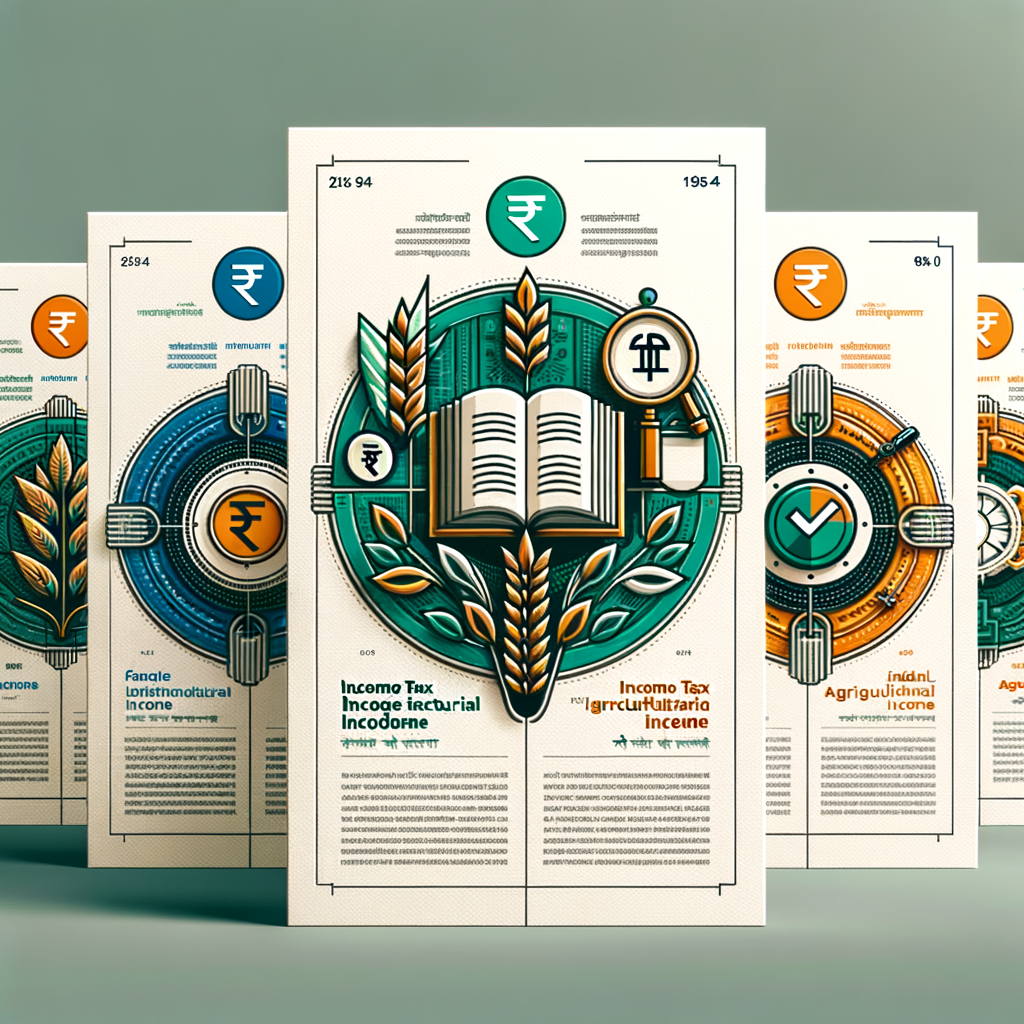How does the Income Tax Act handle agricultural income?
Do you own ancestral farmland or have a side-business in agriculture? Many people believe this income is completely tax-free, but the reality is more complex. While there are significant benefits, understanding the specific rules for income tax agricultural income is crucial for anyone with both farm and non-farm earnings, like salaried professionals or small business owners. The Income Tax Act has a special way of treating this income, which, while exempt, can still influence the total tax you pay on your other earnings. This guide will demystify the rules, breaking down what qualifies as agricultural income, how the tax exemption works, and the critical calculation method you need to know.
What Exactly is “Agricultural Income” Under the Income Tax Act?
Before we dive into the tax implications, it’s essential to understand what the law considers agricultural income. The term isn’t just a general description; it has a precise legal definition under Section 2(1A) of the Income Tax Act, 1961. Simply earning money from rural land isn’t enough. For income to be classified as agricultural, it must fall into specific categories and meet certain conditions. Properly understanding agricultural income under income tax is the first step toward correct tax compliance.
The Three Main Categories of Agricultural Income
The Income Tax Act broadly classifies agricultural income into three types:
- Rent or Revenue from Land: This includes any rent (in cash or kind) or revenue you receive from agricultural land situated in India. For example, if you own farmland and lease it to a tenant farmer who pays you an annual rent, that rental income is considered agricultural income.
- Income from Agricultural Operations: This is the most common form, covering income generated directly from cultivation. It includes the entire process, from tilling the land, sowing seeds, and watering to harvesting the crop. This income must be earned by the cultivator or the person who receives the rent-in-kind (a share of the crop).
- Income from Processing & Sale of Produce: Often, agricultural produce needs basic processing to become marketable. Income from such processes—like curing tobacco leaves, ginning cotton to separate seeds, or turning sugarcane into jaggery—is considered agricultural income. However, this only applies if the process doesn’t fundamentally change the character of the product. The subsequent income from selling this processed produce also falls under this category.
Critical Conditions to Qualify
For any income to be treated as agricultural, two fundamental conditions must be met:
- The land must be situated in India. Income from agricultural land located outside India is not considered agricultural income under the Indian Income Tax Act and is taxable as ‘Income from Other Sources’.
- The land must be actively used for agricultural purposes. This means activities like cultivation and tilling are being performed. If the land is left barren or used for non-agricultural activities, any income derived from it will not qualify for the exemption.
Actionable Tip: For a detailed legal definition, you can refer to the official text of the Income Tax Act on the Income Tax India Website.
The Tax Exemption Myth: Section 10(1) and Its Major Catch
Here’s the part that most people know: agricultural income is exempt from income tax under Section 10(1) of the Income Tax Act. This is absolutely true. The government does not directly levy tax on the profits you earn from farming activities. This is one of the most significant agricultural income tax exemptions in India.
However, the common misconception is that this income is completely ignored when you file your taxes. This is where many taxpayers make a mistake. The exemption has a major catch that affects individuals who have other sources of income, such as a salary, business profits, or capital gains. For those with investments, Understanding Capital Gains Tax in India is also a critical area. This is where the concept of ‘aggregation’ comes in, which can have significant implications of agricultural income tax on your non-agricultural earnings by pushing them into a higher tax slab.
How agricultural income is taxed India: The Indirect Method
While you don’t pay tax directly on your agricultural earnings, this income is used to determine the tax rate applicable to your non-agricultural income. This indirect method is known as the ‘aggregation of income’. The income tax treatment of agricultural income is designed to tax individuals with high agricultural and non-agricultural incomes at a higher rate than those with only non-agricultural income.
When Does the Aggregation Rule Apply?
The aggregation rule doesn’t apply to everyone. It is triggered only when both of the following conditions are met in a financial year:
- Your net agricultural income is more than ₹5,000.
- Your total non-agricultural income is more than the basic exemption limit. For the Financial Year 2023-24 (Assessment Year 2024-25), this limit is:
- ₹2,50,000 for individuals below 60 years.
- ₹3,00,000 for senior citizens (60 to 80 years).
- ₹5,00,000 for super senior citizens (above 80 years).
If you fail to meet even one of these conditions, your agricultural income is fully exempt and will not affect your tax liability.
Step-by-Step Calculation with an Example
Let’s understand how agricultural income is taxed India using a clear example.
Meet Mr. Sharma, a 45-year-old salaried professional. For the Financial Year 2023-24, his income details are:
- Non-Agricultural Income (Salary): ₹9,00,000
- Net Agricultural Income: ₹1,20,000
Since his agricultural income is above ₹5,000 and his non-agricultural income is above the basic exemption limit of ₹2,50,000, the aggregation rule will apply. Here’s how his tax will be calculated (as per the old tax regime slab rates for FY 2023-24):
| Step | Calculation | Amount | Tax Calculation | Tax |
|---|---|---|---|---|
| Step 1 | Add agricultural and non-agricultural income. Calculate tax on the total. | ₹10,20,000 | On first ₹2.5L: Nil On next ₹2.5L: 5% = ₹12,500 On next ₹5L: 20% = ₹1,00,000 On remaining ₹20K: 30% = ₹6,000 |
₹1,18,500 |
| Step 2 | Add agricultural income to the basic exemption limit. Calculate tax on this amount. | ₹3,70,000 (₹2,50,000 + ₹1,20,000) |
On first ₹2.5L: Nil On next ₹1.2L: 5% = ₹6,000 |
₹6,000 |
| Step 3 | Subtract the tax from Step 2 from the tax in Step 1. | – | ₹1,18,500 – ₹6,000 | ₹1,12,500 |
Final Tax Liability:
Mr. Sharma’s net tax payable before cess is ₹1,12,500. A 4% Health and Education Cess will be added to this amount (₹1,12,500 * 4% = ₹4,500), making his total tax liability ₹1,17,000.
If Mr. Sharma had no agricultural income, his tax on ₹9,00,000 would have been ₹92,500 + 4% cess = ₹96,200. The aggregation method increased his tax liability by ₹20,800. This demonstrates how exempt income indirectly increases your total tax outgo. For more details, taxpayers like Mr. Sharma can consult a Step-by-Step Guide to Filing Income Tax Returns for Salaried Individuals in India.
Common Pitfalls: What is NOT Considered Agricultural Income?
One of the most important pieces of income tax advice for farmers in India is to correctly distinguish between agricultural and non-agricultural activities. Many allied activities that seem related to agriculture are actually treated as business income and are fully taxable. Misclassifying this income can lead to scrutiny from the tax department, and is one of the Common Mistakes in Income Tax Returns and How to Avoid Them.
Examples of Taxable Income Sources
Be aware that income from the following sources is not exempt and must be reported as business income or income from other sources:
- Poultry and Dairy Farming: Raising poultry or cattle for milk production is considered a business activity, not agriculture.
- Livestock Breeding: Income from breeding horses, cattle, or other livestock is taxable.
- Bee-keeping (Apiculture): Honey production and bee-keeping are not considered basic agricultural operations.
- Income from Selling Timber: If you sell trees that grew naturally on your land without any active cultivation (like planting, watering, etc.), the income is taxable.
- Income from Farm Buildings: If a farmhouse or building on agricultural land is rented out for commercial purposes (e.g., as a warehouse for a company or for a film shoot), the rental income is taxable.
Understanding these distinctions is crucial for anyone navigating the agricultural income tax rules India.
Conclusion
The rules surrounding agricultural income in India are a perfect example of why tax planning requires careful attention to detail. While your farm income is indeed exempt from direct tax under Section 10(1), it’s not invisible to the Income Tax Department. If your agricultural earnings exceed ₹5,000 and your non-farm income is above the basic exemption limit, this exempt income will be aggregated to calculate the tax on your taxable income, potentially pushing you into a higher tax bracket.
Therefore, it is vital to maintain clear records, accurately distinguish between agricultural and non-agricultural income, and report everything correctly in your income tax return. Understanding the correct income tax agricultural income rules is vital for compliance and accurate tax planning.
The agricultural income and income tax implications India can be tricky. Don’t leave it to chance. For expert guidance on managing your tax obligations, connect with the specialists at TaxRobo Online CA Consultation Service today!
Frequently Asked Questions about Agricultural Income Tax
1. Do I need to report my agricultural income in my Income Tax Return (ITR)?
Answer: Yes. If your agricultural income is over ₹5,000, you must report it in the ‘Schedule EI’ (Exempt Income) section of your ITR form. This is mandatory for transparency and for the aggregation method to be applied correctly if you also have non-agricultural income.
2. Is income from a farmhouse considered agricultural income?
Answer: It depends. If the farmhouse is occupied by the cultivator, is situated on or in the immediate vicinity of the agricultural land, and is used as a dwelling, storehouse, or out-building, it is considered part of agricultural income. However, if it’s rented out for commercial purposes (like a resort or for events), the income is treated as ‘Income from House Property’ and is fully taxable.
3. What if I have only agricultural income and no other source of income?
Answer: If you have no non-agricultural income, your agricultural income is fully exempt from tax, regardless of the amount. In this scenario, you are generally not required to file an income tax return.
4. Is income from growing and selling tea and coffee considered fully agricultural?
Answer: No, the Income Tax Act has specific rules for certain commercial crops that involve both agricultural and business processes. For income from growing and manufacturing tea in India, only 60% is considered exempt agricultural income, while the remaining 40% is taxed as business income. For coffee grown and cured by the seller, 75% is agricultural and 25% is business income. For coffee grown, cured, roasted, and grounded, this ratio changes to 60% agricultural and 40% business income.



